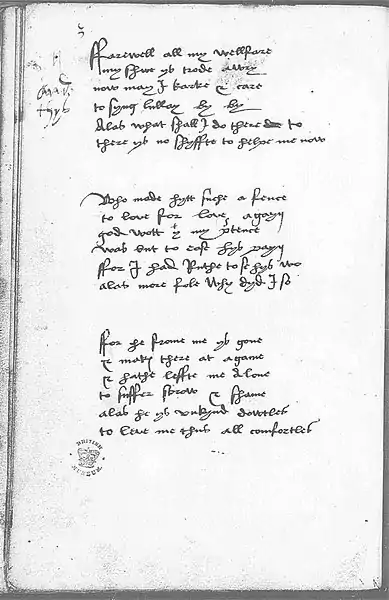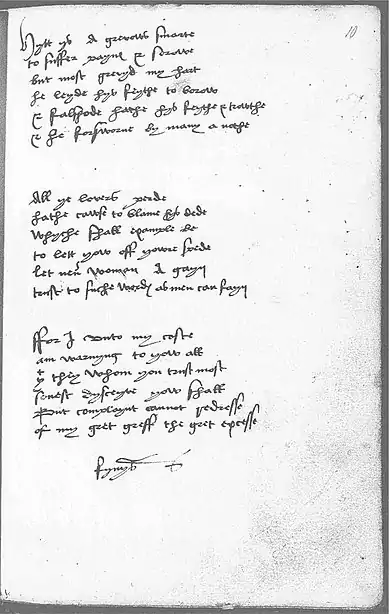|
Introduction | Contributors | Textual Introduction |
| ←Bownd am I now & shall be styll | May not thys hate from the estarte→ |
 The Devonshire Manuscript facsimile 9v |
 The Devonshire Manuscript facsimile 10r |
f. [9v]
1 3# Ffarewell all my wellfare
2 my shwe ys trode awry
3 and thys now may I karke & care
4 to syng lullay by by
5 Alas what shall I do there do to
6 there ys no shyffte to helpe me now
7 Who made hytt suche a fence
8 to love for love agayn
9 {p'}[[The Devonshire Manuscript/Appendix_I:_Paleographic_Features|{{th}+t+}]] god wott that my pretence
10 was but to ease hys payn
11 ffor I had ruthe to se hys wo
12 alas more fole why dyd I so
13 Ffor he frome me ys gone
14 & makes{es} there at a game
15 & hathe leffte me Alone
16 to suffer sorow & shame
17 alas he ys vnkynd dowtles
18 to leve me thus all comfortles
f. [10r]
19 Hytt ys A grevows smarte
20 to suffer paynes{es} & sorowe
21 but most grevyd my hart
22 he leyde hys feythe to borow
23 & falshode hathe hys feythe & trowthe
24 & he forsworne by many a nothe an oath
25 All ye lovers perde
26 hathe cawse to blame hys dede
27 Whyche shall example be
28 to lett yow off yowre spede
29 let neuer{u'} woman A gayn
30 trust to suche wordes{es} as men can fayn
31 Ffor I vnto my coste
32 am warnyng to yow all
33 that[[The Devonshire Manuscript/Appendix_I:_Paleographic_Features|{{th}+t+}]] they whom you trust most
34 sonest dysceyve yow shall
35 But complaynt cannot redresse
36 of my gret greff the gret excesse
fynys s
Commentary
Attributed to Sir Thomas Wyatt,[1] this poem was entered by H2. This poem was written from a woman’s perspective.[2] Rebholz notes that the speaker may be lamenting an unfaithful lover; in particular, line 4 -- that is, "To sing lullay by by" -- denotes her dilemma by alluding to the lullabies she sings to her illegitimate child.[3]
H2 paid particular attention to the presentation of this poem: it begins on the verso of f.9 and continues on the recto of f.10 (facing pages). The stanzas are evenly spaced for the maximum visual effect of balance. "Farewell all my wellfare" is one of seventeen entries in which Margaret Douglas marks: “and thys.” Paul Remley suggests that these annotations relate to another in-text annotation of hers, “lerne but to syng it” (81r), and may indicate a group of texts to be learned for entertaining.[4]
Works Cited
- ↑ R.A. Rebholz, ed., Sir Thomas Wyatt: The Complete Poems (London: Penguin, 1978), 311.
- ↑ We should, however, exercise caution in ascribing a female author to the poem. For a discussion of female voices, see Julia Boffey, "Women Authors and Women's Literacy in Fourteenth- and Fifteenth-Century England," in Women and Literature in Britain, 1150-1500, ed. Carole M. Meale (Cambridge: Cambridge University Press, 1993), 169. and Elizabeth D. Harvey, Ventriloquized Voices: Feminist Theory and English Renaissance Texts (London: Routledge, 1992), 15-24.
- ↑ Rebholz, 536.
- ↑ Paul Remley, "Mary Shelton and Her Tudor Literary Milieu," in Rethinking the Henrician Era: Essays on Early Tudor Texts and Contexts, ed. Peter C. Herman (Urbana: University of Illinois Press, 1994), 40-77.